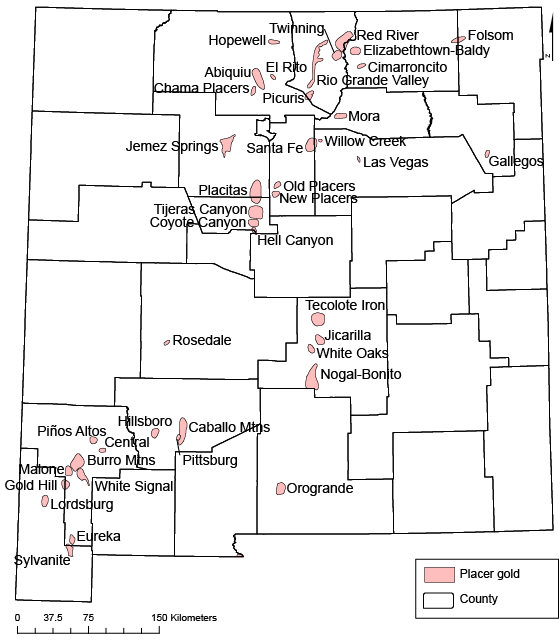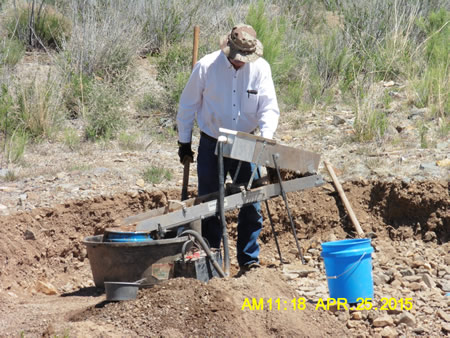
Placer Gold Resources in New Mexico

Placer gold deposits were an important source of gold in New Mexico prior to 1902, but placer production after 1902 has been minor. The earliest reports of placer mining were in the 1600s along the northern Rio Grande. In 1828, large placer deposits were found in the Ortiz Mountains in Santa Fe County (Old Placers district, DIS187), which began one of the earliest gold rushes in the western United States. Known placer gold deposits were found along the southern and eastern flanks of the Ortiz Mountains; however, there could be additional placer gold deposits along the western flanks of the mountain range. Most placer deposits in New Mexico had been discovered by 1900. It is estimated that 662,000 oz of gold have been produced from placer deposits throughout New Mexico from 1828 to 1991. Only four districts have each yielded more than 100,000 oz of placer gold production: Elizabethtown-Baldy (DIS019), Hillsboro (DIS197), Old Placers (DIS187), and New Placers (DIS186).
The deposits generally occur in Late Tertiary- to Holocene-age alluvial fan deposits, bench or terrace gravel deposits, river-bars, and stream deposits or as residual placers formed directly on top of lode deposits typically derived from Proterozoic, Cretaceous, and Tertiary source rocks. During fluvial events, large volumes of sediment containing free gold are transported and deposited in relatively poorly-sorted alluvial and stream deposits. The gold concentrates by gravity in incised stream valleys and alluvial fans in deeply weathered highlands. Because of this natural concentration, some placers are richer in gold than the original lode deposits. Native gold and electrum occurs with quartz, magnetite, ilmenite, amphiboles, pyroxenes, pyrite, zircon, garnet, rutile, and a variety of other heavy minerals. The more productive ore zones typically occur as narrow “pay streaks” or layers of fine-grained, disseminated gold, locally on top of basement rock or clay or caliche lenses within gravel deposits. The higher gold values occur near the base of alluvial gravel deposits where the gold is trapped by natural processes such as riffles in the river bottom, fractures within the bedrock, along bedding or foliation planes, and/or structures that are transverse to the river flow. Gold also concentrates above cemented gravels and clay layers within gravel deposits, which constrain downward migration of gold particles. Most deposits are thin and less than 45 ft below the surface, but thicker deposits are found in the Elizabethtown-Baldy district (up to 275 ft) and in the Rio Grande Valley district (up to 370 ft).

The economic potential of placer deposits in New Mexico is unknown and most known economic placers in the state have been worked. Many streams in New Mexico contain at least traces of gold, enough to satisfy weekend gold panners. The future economic potential will depend upon the discovery of large-volume, medium-grade deposits that can be mined by bulk-mining methods. Lack of water has hampered mining in many districts and new technology, which minimizes water usage, may stimulate activity. Current environmental and permitting restrictions also have hampered recent production in the New Placers and Jicarilla districts. Published historic reserves exist for only two districts: Jicarilla with 5.4 million yd3 of 0.043 oz Au/yd3, or approximately 230,000 oz Au in place and Pittsburg with 2 million yd3 of 0.01 oz Au/yd3, or approximately 20,000 oz Au in place in 1936. Recreational mining continues intermittently in the White Oaks, Pittsburg, Hillsboro, Orogrande and Jicarilla districts to the present day. Several sand and gravel operators periodically extract minor quantities of placer gold from their quarries.

The NMBGMR is conducting a research project examining the origin, occurrence, trace element composition, and resource potential of placer gold deposits in the state. Trace element analysis of placer gold can be used as a valuable exploration tool in order to determine the original deposit source and locating lode gold deposits. Placer gold collected from multiple districts in New Mexico, coupled with a broad database of previously analyzed placer gold samples indicate correlations between chemical signatures (especially gold, silver, and copper) and type of deposits (i.e., Au-rich copper porphyry deposits, Au porphyry deposits, and epithermal deposits). By completing a chemical analysis and determining the particle morphology of placer gold collected from these districts using an electron microprobe, patterns in the chemical signatures from each location can be used to examine chemical variability (1) within the individual placer gold particles, (2) within the same district and (3) among different districts.
References
- Howard, E.V., 1967, Metalliferous occurrences in New Mexico: Phase 1, state resources development plan: State Planning Office, Santa Fe, 270 p.
- Johnson, M.G., 1972, Placer gold deposits of New Mexico: U.S. Geological Survey, Bulletin 1348, 46 p.
- Lindgren, W., Graton, L.C., and Gordon, C.H., 1910, The ore deposits of New Mexico: U.S. Geological Survey, Professional Paper 68, 361 p.
- McLemore, V.T., 1994, Placer gold deposits in New Mexico: New Mexico Geology, v. 16, p. 21-25.
- McLemore, V.T., Dunbar, N., Heizler, L., and Heizler, M., 2014, Geology and mineral deposits of the Orogrande mining district, Jarilla Mountains, Otero County, New Mexico: New Mexico Geological Society, Guidebook 65, p. 247-259.
- McLemore, V.T., 2001, Silver and gold resources in New Mexico: New Mexico Bureau of Mines and Mineral Resources, Resource Map 21, 60 p.
- Luterbach, T.D., and McLemore, V.T. 2016, Trace Element Analysis of Placer Gold Samples (abstr.): GSA Annual Meeting in Denver, Colorado, USA, Paper No. 268-10
- Luterbach, T. and McLemore, V.T., 2016, Trace element analysis of placer gold samples: Society for Mining, Metallurgy, and Exploration, 2016 Annual meeting preprint 16-062, 4 p.

